First-Quarter NBA Awards: Warriors, Stephen Curry stand ahead of pack
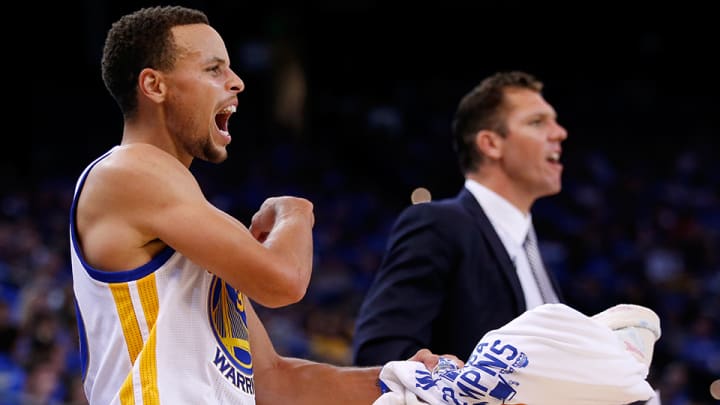
Most of the NBA’s 30 teams have reached the 20-game mark, which means it’s time to hand out some first-quarter awards. While the Warriors and Spurs feature heavily on this ballot, as expected given their strong starts, the rest of the league has plenty of representation, too.
Note: All stats through Dec. 7.
Most Valuable Player
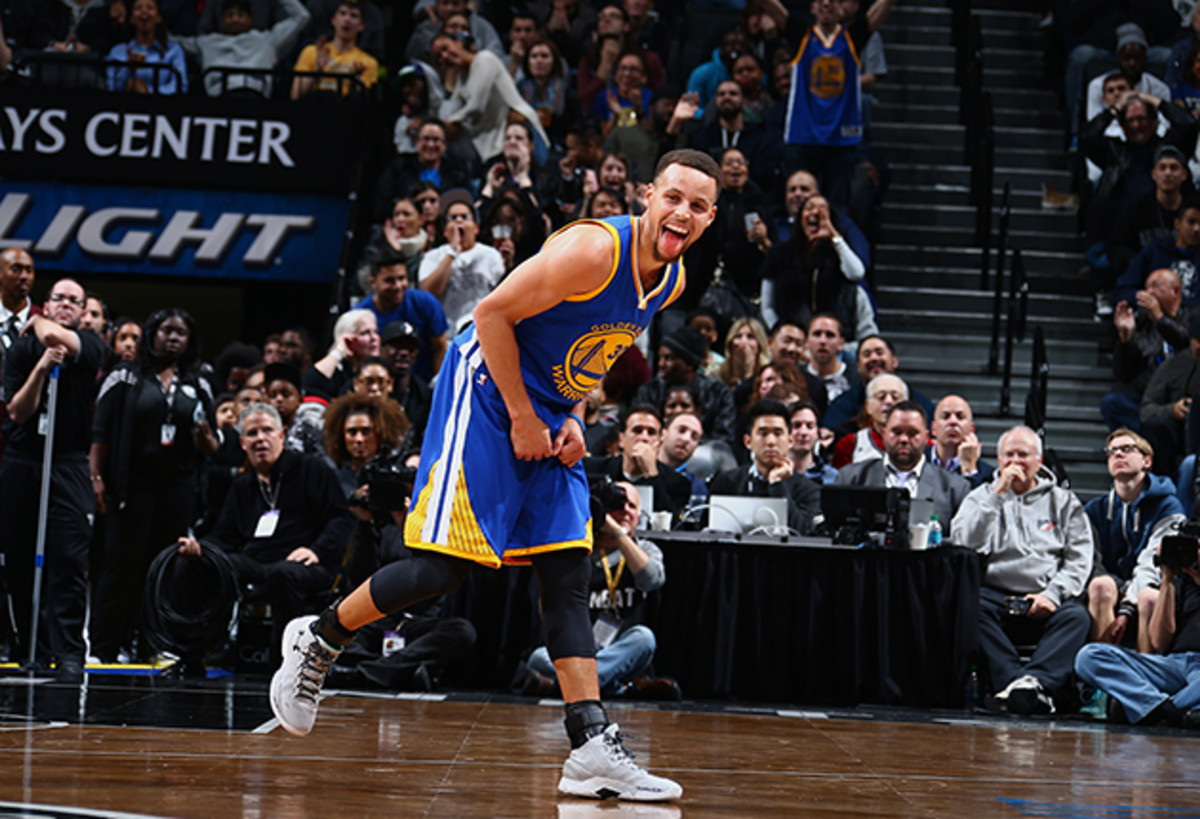
- Stephen Curry, Warriors
- Paul George, Pacers
- Kawhi Leonard, Spurs
- LeBron James, Cavaliers
- Russell Westbrook, Thunder
There’s no MVP debate to be had at this point: Curry leads the NBA in scoring (32.4 PPG), Player Efficiency Rating (35.1), Real Plus Minus (+10.8), and Win Shares (6), he captains the league’s most efficient offense (by a mile), he’s the head of the snake for the most respected and devastating lineup in basketball, and he’s the centerpiece of a 22–0 team that looks fully committed to making a run at 72 wins. Boy, he just might win his first “Players’ Choice” MVP if this keeps up.
Open Floor Podcast: Brad Stevens discusses Celtics, coaching in NBA
For now, Curry isn’t really sparring with his contemporaries, but with the greatest players in NBA history. While he was sensational and fully deserving of the 2015 MVP award, he still qualified as an earthling. He’s been on a completely different planet this season, the basketball version of “Avatar” in 3D. Curry is on track to post the greatest three-point shooting season in NBA history (easily). If maintained, his 35.1 PER would be the highest ever recorded, and he can withstand a good deal of regression and still trump 2009 LeBron James (31.7) and 1988 Michael Jordan (31.7) for the highest mark of the modern era. If maintained, Curry’s Win Shares/48 minutes mark would surpass 1972 Kareem Abdul-Jabbar for the highest of all time while also topping 2013 James and 1991 Jordan for the best in the modern era.
So, Curry has been the NBA’s most productive and most efficient player, he’s been the best player on the best team, he’s been the league’s best story, and he’s on track for a season that would be among the best ever statistically from both an individual and a team standpoint. That leaves one question: Can he become the first unanimous MVP in NBA history?
That question reflects on Curry’s excellence, and it isn’t an indictment of the rest of the field. Indeed, George has been nothing short of spectacular in his first full season after a brutal leg injury. In a normal season, George would make an intriguing foil to Curry in the MVP conversation: his numbers are superb, he’s leading an overachieving Pacers team back towards the top of the East standings, and he boasts an irresistible comeback story. But that “Avatar” other-worldliness gets in the way.
Remarkably, George’s 27.6 PPG/8.2 RPG/4.2 APG averages haven’t been matched for a full season since David Robinson did it in 1994. He’s also been a top 10 performer in PER, Win Shares and Real Plus Minus, and he’s led the Pacers to top 10 rankings in both offensive and defensive efficiency.
Even if George’s scorching outside shooting proves unsustainable as he continues to log heavy minutes, he has delivered on his self-generated preseason MVP hype, he’s singlehandedly provided a balanced and scary identity to a Pacers team in transition, and he’s moved up a few notches on the list of the NBA’s top all-around scoring threats. Look no further than his do-it-all, career-high 48-point explosion against the Jazz over the weekend for proof.
Open Floor: Is it possible to compare Kristaps Porzingis to Dirk Nowitzki?
Leonard beats out James and Westbrook in a tight race for the third spot. The reigning Defensive Player of the Year has helped San Antonio post the league’s top defense at the quarter pole while also averaging a career-high 21.6 PPG and ranking in the top five in Real Plus Minus and PER. The Spurs haven’t fully sorted out their totem pole on offense, especially when it comes to incorporating LaMarcus Aldridge, but Leonard has still been the lead guy for a top 10 attack and helped San Antonio post the league’s second-best record.
His story continues to be one of two-way impact and sustained improvement: Leonard has steadily upped his scoring, rebounding and productivity numbers over his five-year career, he’s the only perimeter player averaging at least a steal and a block per game, he can generate offense from the post or in transition, and he’s developed into a consistent perimeter threat (he’s shooting a Kyle Korver-esque 50% on threes to date). Most importantly, he’s managed to avoid the lengthy absences that sidetracked each of his last three seasons. Leonard should be a lock to finally make his first All-Star Game this season and he’s tracking towards an appearance on the All-NBA First or Second team.
It’s best to reserve a definitive judgment on James, who has carried a heavy (too heavy) offensive burden due to the absences of Kyrie Irving and Iman Shumpert. His per-game numbers are typically ostentatious—26.2 PPG, 7.8 RPG, and 6.5 APG—and he’s been among the league leaders when it comes to fourth-quarter production. Even so, there’s a perception that something is missing: his perimeter shooting has been especially spotty, the Cavaliers have been merely impressive rather than world-beating, and his advanced stats—top 10 rankings in PER, Win Shares and Real Plus Minus—are very strong but no longer transcendent like they were from 2008 through 2014. Where’s the merciless, awe-inspiring invulnerability? Where’s the buzz?
If Lee Jenkins’ latest profile for Sports Illustrated is any indication, the 30-year-old James is pressing and straining in an attempt to keep pace with the ascending Warriors. That’s understandable. As recently as 14 months ago, James’s homecoming to Cleveland was the league’s dominant storyline and he seemed to be positioned to continue stacking up Finals appearances, MVPs and even rings. As recently as six months ago, his Cavaliers were leading the Warriors in the Finals, 2–1. But Golden State’s unprecedented start has a warping effect, to the point that it might feel like the accolades James spent years accumulating in routine fashion are now outside of his grasp.
That’s going too far. If Cleveland can get its core pieces on the court together for the stretch run, James should have every opportunity to finish in the top three of MVP voting for the eighth straight year and make the Finals for the sixth straight time. For now, it’s best not to assume that James is at his best until the Cavaliers are at their best.
Westbrook, meanwhile, has been as tantalizing as ever this season. Like Curry and George, he’s putting up unique numbers the NBA hasn’t seen in decades: Westbrook’s 27 PPG/9 APG/7 RPG production hasn’t been matched by anyone for a full season since Oscar Robertson (who did it every year from 1960 to 1965), and he’s next up behind Curry in most of the major advanced stats.
Unfortunately, both Westbrook and the Thunder as a whole are stuck facing many of the same old questions early on. His shot selection has been a little too loose, his turnover rate has climbed to a career-worst level, and Oklahoma City’s offense is potent but not all that cohesive. Even with Westbrook doing it all, the Thunder were decidedly mediocre when Kevin Durant was briefly sidelined due to injury, and they are already well behind the pace set by the Warriors and Spurs. Much like last season, when Westbrook finished fourth during Oklahoma City’s 45-win season, the Thunder will need to come closer to reaching their full potential if their prolific point guard is going to climb higher in the MVP conversation.
Clippers forward Blake Griffin and Durant are both worthy of the “honorable mention” tag.
Rookie of the Year
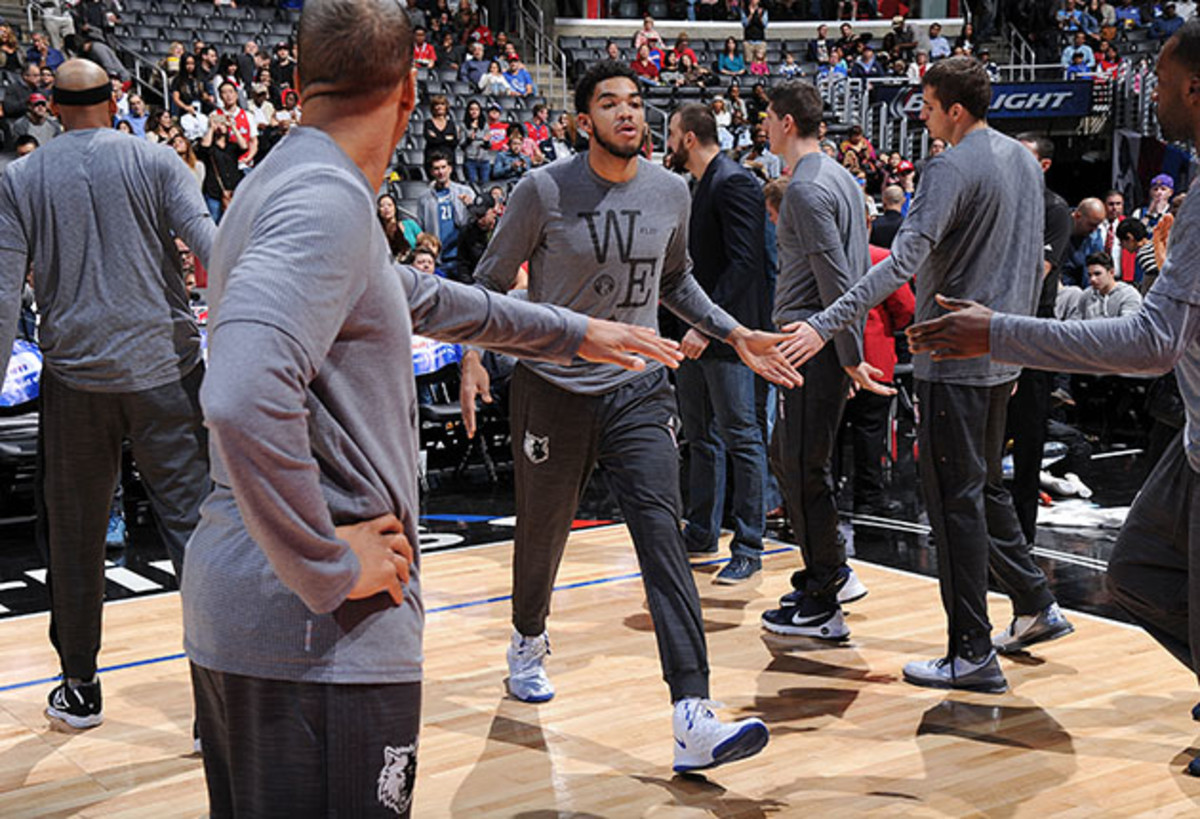
This is one of the best Rookie of the Year races in recent memory. The parallels between the top two candidates, Towns and Porzingis, are endless, even if the former comes by way of John Calipari’s basketball prodigy factory and the latter comes from Latvia.
Both are instant impact contributors who have acquitted themselves well as full-time starters. Both play for teams that have moved past disastrous 2014–15 seasons to regain respectability. Both are still just 20 years old so their rookie stats aren’t age-inflated. Both project as distinctly “modern” big men, thereby maximizing the hope factor for their franchises. Their statistical profiles are practically mirror images.
- Towns: 27.8 MPG, 14.8 PPG, 9.1 RPG, 2.2 BPG, 52.8 FG%, 21.4 PER, 1.8 Win Shares
- Porzingis: 28 MPG, 14.6 PPG, 8.9 RPG, 1.9 BPG, 46 FG%, 20.5 PER, 2 Win Shares
Towns gets the nod based on his slight efficiency advantage and his general polish (even though he made a classic rookie mistake by committing an off-the-ball foul late in a loss to the Clippers on Monday). His ceiling this season also appears higher than Porzingis’s based on Sam Mitchell’s conservative handling of his playing time to date.
After the Timberwolves ran Andrew Wiggins into the ground last season, Mitchell has opted for a lighter touch with Towns, even keeping the No. 1 overall pick on the sidelines late in recent games. “I’m comfortable with Karl down the stretch,” Mitchell insisted after a Nov. 29 loss to the Clippers, in which Towns sat out for the first 9+ minutes of the fourth quarter. “Karl is a great teammate and a great team player.”
Two games later, Towns was pulled before what proved to be the critical play of a close loss to the Blazers. The local media in Minnesota rightfully questioned that decision, as Damian Lillard was able to loft the decisive runner over the top of Tayshaun Prince, Towns’s replacement. Mitchell defended his decision on the grounds that he needed to match-up from a position standpoint, a stance that seems to overlook Towns’s versatility.
As an interim coach, Mitchell faces a delicate balance between gunning all out for wins and ushering in a full youth movement. That said, it’s really not asking too much for Mitchell to make Towns a mandatory piece in his closing lineups. The long-term gains overwhelmingly outweigh any short-term pains, and there’s no time like the present for Towns to work through the rookie mistakes. This is an intelligent, well-rounded, athletic big man with good instincts and feel. It won’t be long before he’s turning in game-winning plays and making Mitchell, or his eventual replacement, look like a genius.
Open Floor: Is it possible to compare Kristaps Porzingis to Dirk Nowitzki?
Porzingis, meanwhile, is just living the dream. Who would have thought that the words “delightful” and “New York Knicks” would regularly appear in the same sentence so quickly after a 17-win season? It’s not hyperbolic to suggest that Porzingis represents a long-term plan for the franchise in and of himself. Carmelo Anthony’s inevitable and ongoing decline continues to be problematic, but it no longer looks like the fate-sealer that it seemed to be as recently as June. Nothing lifts spirits city-wide quite like a productive, likeable, focused rookie who will likely be locked into his current market for at least the next seven or eight seasons. The cherry on the sundae is that Porzingis can shift between the four and the five, making it that much easier to find frontcourt partners for him down the road.
The third spot here is much trickier, particularly when you weigh the advanced numbers. The group of candidates includes three players logging big minutes and posting ugly advanced numbers for bad teams (Jahlil Okafor, D’Angelo Russell and Emmanuel Mudiay), a solid contributor posting respectable numbers for a very good team (Justise Winslow), and two role players with recent injury issues (Willie Cauley-Stein and Rondae Hollis-Jefferson).
It’s just too painful to reward Okafor, given his multiple off-court incidents, his league-worst -5.99 Real Plus Minus, and his atrocious -18.8 net rating. His unusual team circumstances aren’t doing him any favors, but his gaudy per-game numbers (16.9 PPG and 7.9 RPG) simply lack credibility in the face of Philadelphia’s 1–21 start and his performance on the impact stats relative to his own teammates.
As harsh as it might sound, Okafor has performed like a method actor tasked with mimicking Enes Kanter on his worst day. While the No. 3 pick didn’t necessarily need to emerge as the team’s savior on Day One, he must do a little better than trashing a pristine reputation so badly that he had to be assigned a security babysitter less than two months into his career. GM Sam Hinkie paid for his role in this mess with the hiring of Jerry Colangelo on Monday. Hopefully, Okafor welcomes this shift in authority as motivation for improving his own accountability both on and off the court.
By process of elimination, Winslow looks like the best of the Okafor alternatives. Although his small offensive role and second-unit status contribute to his middling PER, he’s been a productive rebounder and a plus defender for one of the East’s top teams. His body of work has mattered and it has helped his team’s cause, which is more than can be said for Okafor. This third spot will remain in flux as Okafor works to right himself, and as Russell and Mudiay, among others, find their sea legs.
Defensive Player of the Year
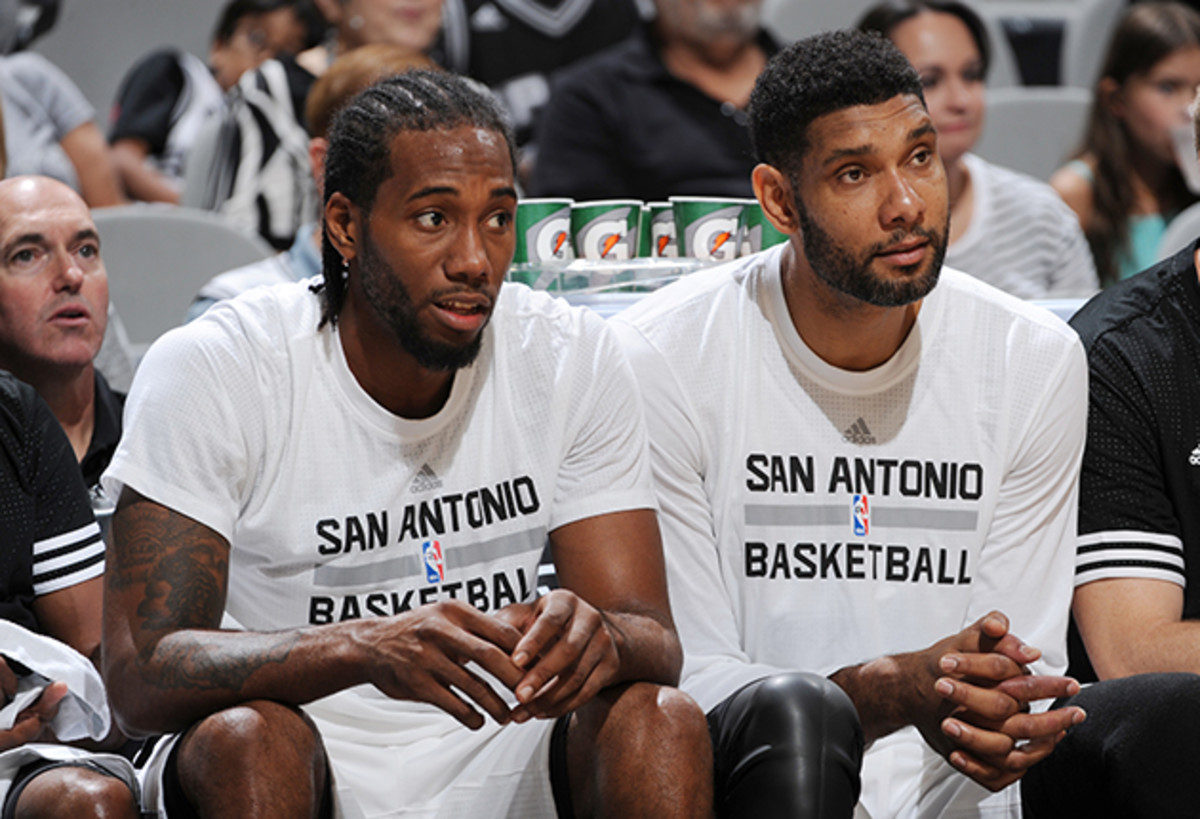
- Kawhi Leonard, Spurs
- Tim Duncan, Spurs
- Draymond Green, Warriors
The gap between Golden State’s No. 1 ranked offense (114.1 offensive rating) and Oklahoma City’s No. 2 ranked offense (106.3) is so laughably large that it’s cause for impartial observers to wonder whether the Warriors will make a mockery of the 2016 postseason. There is a worthy counter-argument: San Antonio’s No. 1-ranked defense (92 defensive rating) is substantially better than everyone else’s (Miami is No. 2 with a 96 defensive rating). Although the size of that gap might not inspire guffaws, it does demand respect. Lots of respect.
A major key behind San Antonio’s defensive success has been its good health. The Spurs’ new starting five of Tony Parker, Danny Green, Leonard, LaMarcus Aldridge and Duncan has already logged more minutes together this season than any Spurs lineup from the 2013–14 or 2014–15 seasons. Together, that big, long, athletic and star-studded frontline has posted a 96.2 defensive rating. Two of coach Gregg Popovich’s other favorite configurations—swapping in Manu Ginobili for Green and replacing Duncan with Boris Diaw—have posted even stingier defensive numbers.
The common thread in those lineups is Leonard, the reigning Defensive Player of the Year. Despite a rise in his usage rate and scoring, Leonard remains an active, smart, imposing and physical presence on the defensive end. To no one’s great surprise, he leads all perimeter players with a +3.5 Defensive Real Plus Minus. Leonard has added to his reputation for rising to the occasion in high-profile matchups against star wings this season, and his ability to handle multiple positions will prove key to San Antonio’s ability to match up with Golden State. He is as skilled and as indispensable as any defender in the league.
Colangelo's input can help 76ers, but 'process' doesn't need interrupting
At the same time, Duncan has been amazing and fully deserving of Defensive Player of the Year buzz in his own right. At 39, he leads all players with a +6.2 Defensive Real Plus Minus and his “Twin Towers” pairing with Aldridge has helped San Antonio hold opponents to a league-best 52.3% within five feet. If there’s a tiebreaker between Leonard and Duncan at this point, it’s probably Leonard’s lineup versatility combined with his ability to handle a larger playing-time load on a night-to-night basis. Popovich is surely glad he doesn’t need to pick between the two, as both will be central to San Antonio’s hopes of upsetting Golden State.
Speaking of the Warriors, Green also needs to be in this conversation. It’s been easy to overlook Golden State’s defensive consistency, what with Curry dominating the headlines and Green creating his share of highlights with his development as a fast-break initiator. Yes, it needs to be pointed out that the Warriors have slipped to fifth in defensive efficiency after ranking first last year, in part due to injuries to Andrew Bogut and Harrison Barnes that have led to some lineup juggling.
Nevertheless, Golden State can still turn the screws as tightly as anybody when the need arises. As with Leonard, positional versatility remains Green’s calling card. Golden State’s preferred small-ball lineup has posted an outrageous 84.8 defensive rating (in limited minutes) thanks first and foremost to Green’s ability to shift up to handle the center positions. When he plays power forward in traditional lineups, Green continues to distinguish himself with his energy, relentlessness and switching ability. A fat, new contract has done nothing to diminish his persistent influence over gameplay.
Most Improved Player
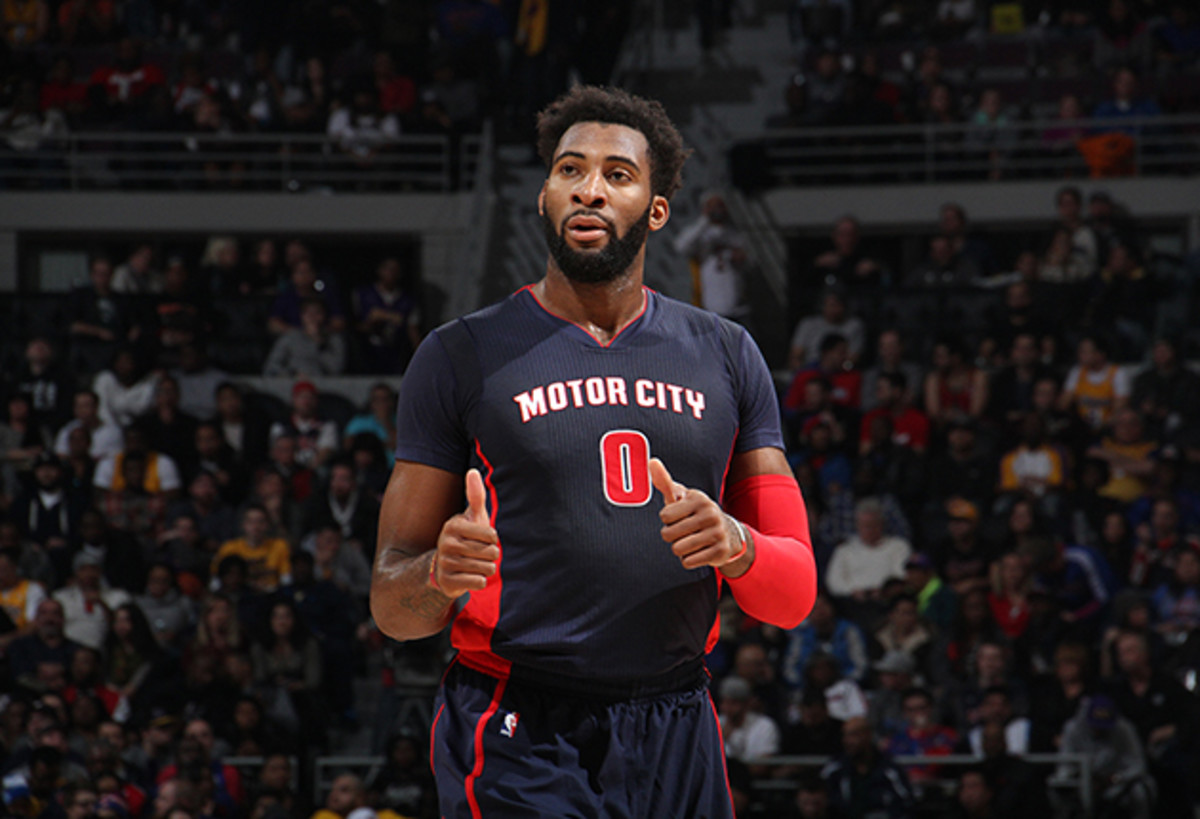
- Andre Drummond, Pistons
- CJ McCollum, Blazers
- Clint Capela, Rockets
Go ahead and make the case for Curry as the NBA’s Most Improved Player. It’s a strong one. But this award historically goes to players who make the jump “from obscure to reliable” or “from good to great.” Curry obviously fits neither of those categories, so he will be respectfully passed over on this ballot. Anyway, this award seems too trivial for someone who is making the leap from “MVP” to “Super MVP.”
Drummond fits cleanly into the “from good to great” category: he’s ramped up his production, he’s refined his skillset, and he’s been a driver of his team’s newfound success. In his first season as the Pistons’ undisputed centerpiece—now that Greg Monroe is gone and coach Stan Van Gundy’s offense has been fully recalibrated around him—Drummond is averaging 18 PPG (4.2 points above last year’s mark), he’s pulling down a league-leading 16.5 RPG and he’s the back line anchor of a top 10 defense.
Importantly, Drummond, 22, has maintained a level of consistency that eluded him last season while helping Detroit (12–10) to its most promising start in ages. With PER and Real Plus Minus numbers that rank among the best at his position, Drummond looks like a solid bet to make his first All-Star Game this season. And, for what it’s worth, the last player to average 16 boards a night was 1997 Dennis Rodman. Pulling off that feat would surely be deserving of some individual hardware.
• MORE NBA: Power Rankings: Warriors bring the circus to town
McCollum entered the season as one of the Most Improved Player favorites and he hasn’t disappointed, averaging 19.4 PPG in a starting role after scoring just 6.8 PPG in a smaller back-up job last year. The nature of his game remains the same: the 24-year-old guard loves looking for his shot off the dribble and he isn’t bashful about pulling the trigger. He’s just doing it a lot more this year.
Although Portland’s forgettable record and his status as a minus defender might eventually hold back his candidacy, McCollum has become a bedrock piece for coach Terry Stotts. As the reloading Blazers contemplate what comes, they do so knowing that they have two high-volume scorers with game-breaking potential in Damian Lillard and McCollum to build around.
Houston’s season, meanwhile, has been widely panned. That heckling is fully deserved in light of the Rockets’ disappointing record, James Harden’s maddening ups and downs, Ty Lawson’s disastrous arrival, and the quick firing of coach Kevin McHale.
However, Capela has emerged as a bright spot. The 2014 first-round pick spent most of last season in the D-League before catching on prior to the Rockets’ playoff run. The long-armed, 6’10” big man is averaging 8 PPG and 6.6 RPG in 19.4 MPG this season, and he’s pushed his way into Houston’s starting lineup in recent weeks thanks to his efficient finishing, productive rebounding and rim-protecting ability.
That promotion and expanded role look warranted: Capela’s +2.6 net rating is tops among Houston’s rotation players, he fares very well by PER and Real Plus Minus, and the 21-year-old’s length and potential combine to make him a possible long-term replacement for Dwight Howard, in the event the All-Star center leaves in free agency next summer. Not bad for a guy who logged just 90 regular-season minutes as a rookie last year.
Sixth Man of the Year
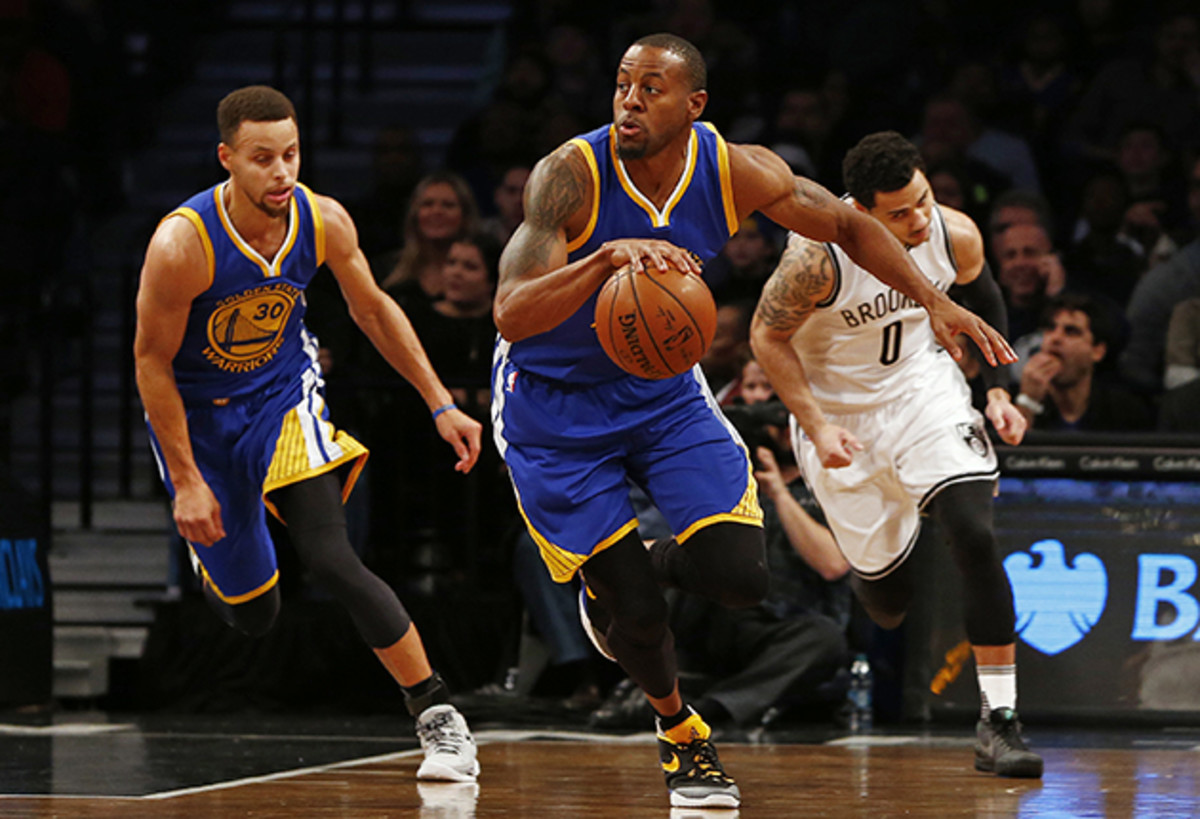
- Andre Iguodala, Warriors
- Manu Ginobili, Spurs
- Cory Joseph, Raptors
The Sixth Man of the Year race usually takes some time to shake out, as sample sizes increase and as coaches settle on their starting lineups and rotations. For the sake of this exercise, only players with five or more starts this season were considered.
This ballot attempted to look past high-volume/low-efficiency scorers or one-way guys in favor of quality contributors with a demonstrated positive impact on good teams. As luck would have it, both the Warriors and Spurs owe a chunk of their early success to established Sixth Man candidates in Iguodala and Ginobili.
Curry and Green aside, Iguodala has probably been Golden State’s most important player this season. The 2015 Finals MVP has supplemented his multi-positional defensive ability and ballhandling skills with uncharacteristically effective three-point shooting. Indeed, the Warriors never seem more difficult to beat than when Iguodala cashes in a wide open corner three as the possession’s fourth or fifth scoring option. A key piece in Golden State’s ultra-versatile small lineup, Iguodala has posted a +21.6 net rating and a +3.4 Real Plus Minus so far this season. Trust those eye-popping impact numbers over his pedestrian per-game tallies (8 PPG, 4.6 RPG, 3.6 APG).
Ginobili has shaken off his 2015 postseason struggles to post a team-best +19.7 net rating off the bench for San Antonio. Although he’s filling a purposefully controlled role, playing just a bit over 20 minutes a night at age 38, Ginobili remains an effective shot-creator and distributor. His PER, Win Shares and Real Plus Minus all rank among the top among bench players.
For now, the third spot goes to Joseph, who is one of several key additions to a revamped Raptors rotation. The back-up guard has posted a strong +7.2 net rating, and Toronto’s defensive efficiency is 7.6 points better when he takes the court. A recent game-winner highlighted a smooth homecoming for the Canadian, as he’s averaged 9.8 PPG and 2.9 APG for the Raptors (13–9).
Others to watch as this race unfolds include Ryan Anderson, Alec Burks, Jeremy Lamb, Darren Collison, Jamal Crawford and T.J. Warren, among others. Enes Kanter’s per-game stats will likely make him a factor as well, even if the impact stats continue to look upon him unfavorably due to his defensive limitations.
Coach of the Year
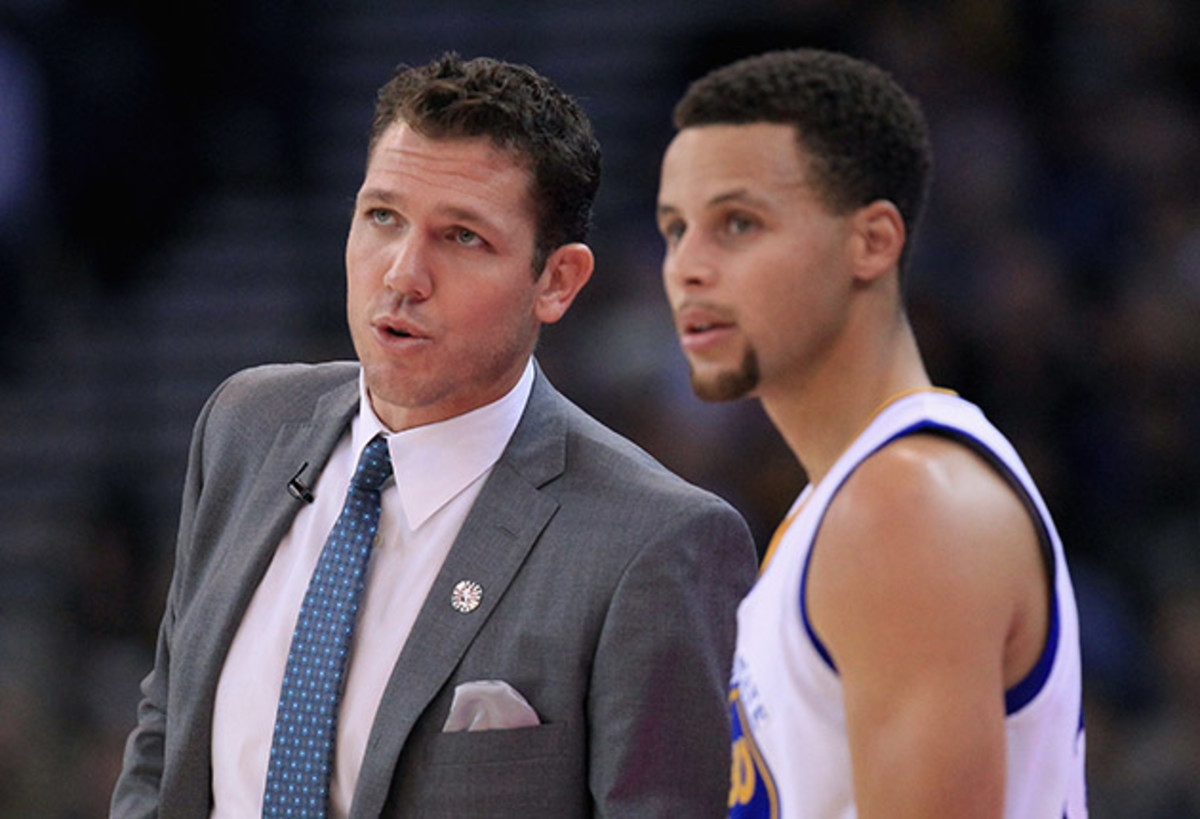
When in doubt, go with the coach who hasn’t lost a game.
In all seriousness, though, Golden State’s 22–0 start is a powerful testament to Steve Kerr’s culture-building. Not only did Kerr win 67 games and a title in his rookie season, he constructed an environment that was solid enough to withstand his own absence, injuries to multiple starters, a little preseason contract negotiation drama (Barnes), and the perpetual media scrutiny that comes with being the defending champions.
The ultra-laid back Walton nevertheless deserves his share of the credit, especially because this year’s wins are officially going on Kerr’s record. While his chief accomplishment has been maintaining a light touch so as not to mess up a good thing, Walton has also allowed Curry and Green to play even more freely than last season without sacrificing the team concept. The results have been an improved offense and a trickle-down confidence that regularly intimidates opponents. Walton has also overseen multiple comeback wins without running his stars into the ground, and he’s been intentionally judicious in deploying his killer small ball lineup. Any nits that critics might want to pick are, by definition, minor: It’s Dec. 8 and the guy is somehow still undefeated.
Filling out the rest of the ballot is a pretty fruitless exercise: the top 10 teams in the East are separated by two games and the West’s No. 3 through No. 9 seeds are all still bundled within four games. Parity is one of the key early themes of this 2015–16 season, and that tight packing might well turn this month’s “pleasant surprises” into “disappointments” by Christmas. Right now, the difference between overachieving and underachieving is one bad week.
With that background in place, both Carlisle and Clifford fully deserve praise for managing particularly troubling waters. And what do you know? Both the Mavericks and Hornets rewarded their coaches with early contract extensions.
In Dallas, Carlisle has resurrected Deron Williams (seems impossible), received quality minutes from Raymond Felton (seems impossible), worked around a recovering Chandler Parsons (not easy), trusted a gung-ho Wesley Matthews (easier said than done), kept Dirk Nowitzki going, deployed Zaza Pachulia to great effect, and patched together oddball lineups that have consistently functioned far better than they look on paper. The Mavericks (13-9) will have their hands full holding off the long list of playoff hopefuls stacking up behind them, but they are the easy pick as the NBA’s top overachievers to date. Hats off to Carlisle.
Clifford has done well to avoid letting a long-term injury to Michael Kidd-Gilchrist define his team’s season. Charlotte’s offensive efficiency has skyrocketed from No. 28 last year to No. 6 this year thanks to the addition of Nicolas Batum, who is off to a hot start in a contract year, and an increased emphasis on spacing, three-point shooting and ball movement. Many teams have taken a similar approach but few have achieved such dramatic results.
The Hornets (12–8) have generally been outclassed by A-list competition, but there are enough guys chipping in (Jeremy Lin, Jeremy Lamb, etc.) that a return to the playoffs should remain on the table for a while. That’s saying something given the newfound strength of the East’s middle class.
